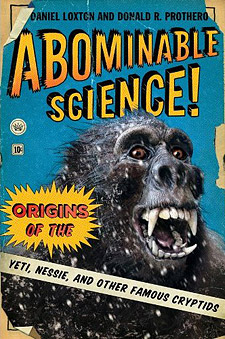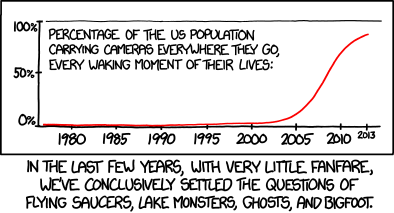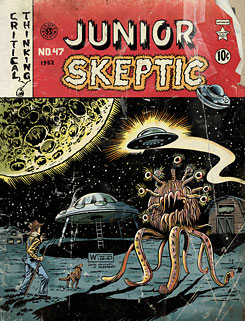In this week’s eSkeptic:
Abominable Science!: Origins of the Yeti, Nessie, and Other Famous Cryptids
THROUGHOUT OUR HISTORY, humans have been captivated by mythic beasts and legendary creatures. Tales of Bigfoot, the Yeti, and the Loch Ness monster are part of our collective experience. Now comes a book from two of Skeptic’s dedicated investigators that explores and elucidates the fascinating world of cryptozoology.
We are excited to announce the release of Daniel Loxton and Donald R. Prothero’s new book Abominable Science!: Origins of the Yeti, Nessie, and Other Famous Cryptids. An entertaining, educational, and definitive text on cryptids (a creature whose existence is unsubstantiated or disputed), the authors of this book present the arguments both for and against the existence of these creatures and systematically challenge the pseudoscience that perpetuates their myths.
“Accessible and absorbing…. Highly recommended for readers looking for scientific but accessible evaluations of the existence of five notable cryptids that have captured our imaginations. Likely to be popular.”
“This work is as valuable for its analysis of the hunted as it is for the light it shines on the still-hopeful hunters.”
“[R]iveting…. Abominable Science! is a well-told, engaging story of skepticism. Loxton and Prothero present a lucid and compelling case to counter the false claims of cryptozoology.”
“Here, at last, is a scholarly, fully referenced work that presents a thoroughly reasonable, well-argued, skeptical perspective on some of the most iconic ‘cryptids,’ and it is fun to read and well illustrated to boot.”
“[E]ntertaining, educational, passionate, and valuable…. With marvelous artwork and deeply researched histories of the various creatures, this is an impressive and authoritative book.”
About this week’s eSkeptic
When the story came out that Bigfoot DNA had been found, everyone was talking about it—and some of us were skeptical. In this week’s eSkeptic, Donald R. Prothero reports on what happened when an independent lab checked the samples. Read Prothero’s bio after the article. This post first appeared on Skepticblog.org.
Bigfoot DNA? It’s Playing Possum!
by Donald R. Prothero
Last February, the news and blogosphere was buzzing with excitement. Someone had claimed that they had sequenced the DNA of Bigfoot! Naturally, such a sensational story was reported all over the internet and even the mainstream media as if it were solid, confirmed research. If there was any skepticism displayed, it was at the very end of a story that mostly gave the claim uncritical coverage. A number of mainstream scientists and skeptics wrote critical blogs and articles about the way the discovery was announced and the fact that it was announced without a publication backing it up, but everyone had to reserve judgment until the paper was actually published—and even more importantly, when the results were double-checked by an independent lab.
There were lots of reason for doubting the reality of the report. To start with, the researcher, Dr. Melba Ketchum (a long-term Bigfoot advocate, so she is no neutral party) did one of the worst possible things to convince scientists: she put out a press release before any peer-reviewed scientific publication of results. This always makes scientists suspicious, because it is a common strategy among less reputable researchers to get the press to cover substandard or even ridiculous research before scientists could weigh in.
Then the red flags kept on coming. Her lab, which mostly does DNA analysis for veterinarians, was given an “F” rating with the Better Business Bureau. When the paper finally appeared, it was not in a peer-reviewed journal that scientists trust, but in some unknown source called DeNovo Scientific Journal. It was the only paper in this online journal, another suspicious aspect of the research. And it took only a little bit of digging to find out that that Melba Ketchum had bought the journal itself and had no independent editorial board, so the research was completely self-published with no neutral peer review or quality control. Even Bigfoot advocate Jeff Meldrum found this suspicious:
“To make an end-run around the process by erecting a facade in the form of a so-called new journal and allege that it is edited and reviewed, without providing any of that information on the public web page, it appears that she has undertaken an effort to self-publish, just to get it out there,” Meldrum told The Huffington Post. “And, to boot, she’s charging $30 a pop for a copy of the paper. Meldrum said he doesn’t think any credible scientific journal would shy away from the topic simply because of its controversial nature. “I wouldn’t rule it out entirely. There are certainly politics involved in the selection of papers. If it’s solid work, this is the discovery of the century, if not the millennium,” Meldrum said. “Any journal, if they were confident in the results and in the expertise of their reviewers, and it came down positive —I would think they would clamor for the opportunity to have that on the front cover of their journal.”
Throughout the long wait for the paper to appear, rumors were flying. There were lots of conflicting stories about whether it was under review or not, and a Russian co-author leaked all sorts of information that was not consistent with what Ketchum’s lab was saying. The press release and other announcements claimed that all the mitochondrial DNA was human (no surprise), and come from normal human hair which has mitochondrial DNA but no nuclear DNA. The nuclear DNA largely matches human samples as well, along with an “unknown component” that Ketchum prematurely attributes to Bigfoot. As our own Steve Novella put it:
Let me offer a preliminary alternate hypothesis. The hair samples that contain only human mtDNA are from a human. The samples from which the nuDNA is isolated are also from humans but with some contaminants or some other animal source mixed in. That seems to be a more parsimonious interpretation. I would like to know more about the source of the DNA, but I guess that will have to wait for the full details to be published. The fact that the human DNA is modern human (hence the need for the alleged hybridization to have occurred so recently in the past) is most easily explained as the source simply being modern humans. Let us also consider the scenario that Ketchum is suggesting—in the very recent past (less than 15,000 years) an unknown primate bred with modern human females (mtDNA comes almost exclusively from the female line) producing the creature we now know as bigfoot. What, then, must the original unknown primate looked like? The result of this pairing then produced fertile offspring, enough to generate a new stable population of bigfeet. It is highly doubtful that the offspring of a creature that looks like bigfoot and a human would be fertile. They would almost certainly be as sterile as mules. Humans could not breed with our closest living relatives, the chimpanzees, or any living ape. It is probable that we could produce fertile young with Neanderthals, but it gets doubtful the further back in our evolutionary history we go – and how far back would we have to go to reach a common ancestor with bigfoot? The bottom line is this—human DNA plus some anomalies or unknowns does not equal an impossible human-ape hybrid. It equals human DNA plus some anomalies.
One of the first people to get an advance peek at the paper, geneticist John Timmer of the online journal Ars Technica, reported:
At this point, we get into some actual biology with enough details to analyze. And the details appear to point in the exact opposite direction of the authors’ conclusions that bigfoot represents a recent hybridization between modern humans and an unknown species of primate. To begin with, the mitochondrial DNA of the samples (when it can be isolated) clusters with that of modern humans. That isn’t itself a problem if we assume that those doing the interbreeding were human females, but the DNA sequences come from a variety of different humans—16 in total. And most of these were “European or Middle Eastern in origin” with a few “African and American Indian haplotypes.” Given the timing of the interbreeding, we should only be seeing Native American sequences here. The authors speculate that some humans may have walked across the ice through Greenland during the last glaciation, but there’s absolutely no evidence for that. The best explanation here is contamination.As far as the nuclear genome is concerned, the results are a mess. Sometimes the tests picked up human DNA. Other times, they didn’t. Sometimes the tests failed entirely. The products of the DNA amplifications performed on the samples look about like what you’d expect when the reaction didn’t amplify the intended sequence. And electron micrographs of the DNA isolated from these samples show patches of double- and single-stranded DNA intermixed. This is what you might expect if two distantly related species had their DNA mixed—the protein-coding sequences would hybridize, and the intervening sections wouldn’t. All of this suggests modern human DNA intermingled with some other contaminant.
When the paper was finally available, it was accessible only behind a paywall that had a $30 charge for one paper. It is common in these commercial journals to charge a small amount for an individual paper, but a fee this large, going directly to the pockets of the author who owns the journal, suggests that she was milking the site for money from dedicated Bigfoot believers, and discouraging most scientists (who are not interested enough in the issue to waste $30) from accessing it. Others have suggested that since her company got the “F” ranking from Better Business Bureau and is tanking, she dreamed the whole thing up as a scheme to raise money from the Bigfooters.
I finally got a look at the paper for myself. Most of it reads like a conventional DNA paper, and the results don’t look that oddball since they are presented in a normal fashion. (By contrast, many crackpot papers have bizarre writing and structure, often presented in a weird font like Comic Sans). There is a section claiming that they eliminated questionable hair samples by comparing their samples to reference samples of hairs of humans and other common North American mammals. Only hairs which had a “novel visual structure” (p. 3) were said to have been used in the study.
Then there were other samples that included “toenail, tissue, blood, mucus, scratched tree bark and saliva claimed by submitters to be from an unknown and previously undescribed hominin”. They came from 14 states and 2 Canadian provinces. “Samples were subjected to a preliminary screening by utilizing eyewitness interview information, visual and histological examination, and DNA testing.” What?? This is the key issue that screams out for further investigation. Her samples were collected by people who claimed to witness Bigfoot, yet there is no identification of the source, where it came from, and how they know it came from Bigfoot—an inexcusable gap in the essential data allowing us to assess the reliability of the collecting procedures. More significantly, not one of them was able to get a photograph of Bigfoot as it left tissues behind. I find that very hard to believe in a day when nearly everyone carries a cell phone camera in their pocket. Surely a photo would provide much more convincing evidence that the sample allegedly derived from Bigfoot. There are accounts of how the “blood sample” was obtained when Bigfoot cut its lip sucking on a sharp rain gutter. If the witness saw that much up close, why are there no pictures? This doesn’t give us any confidence that these “eyewitnesses” actually saw a Bigfoot leave the sample behind. Instead, it suggests that sampling is much less rigorous and second-hand, as indicated by the story that some of her samples came from a blueberry bagel left out in a Michigan back yard that is claimed to be frequented by Bigfoot. This xkcd cartoon says it all:
And this begs an even larger question: if we have an unknown DNA sample, how do we know it’s from Bigfoot? We cannot just assume that if it doesn’t come from a known North American mammal, it’s automatically from Bigfoot. Without already having Bigfoot in captivity to sample from, all we can say about an unknown DNA sample is that it’s from an unknown source! This a common problem with cryptozoologists and pseudoscientists: if there is some phenomenon that is not yet easily explained by science, they assume that it must be caused by Bigfoot or ghosts or UFOs or some other supernatural cause. The proper scientific assumption is that if the cause is not yet known, we don’t jump to supernatural conclusions—we just don’t know the cause yet.
Well, the verdict is in. Ketchum sent reporter Eric Berger of The Houston Chronicle her samples so he could get them tested by a reputable independent geneticist. The result? Mostly just regular human DNA, with contamination by a number of critters, including an opossum! Ketchum describes her lab procedures in detail in the paper, and claims she had samples of other North American mammals to rule out their input. Apparently she forgot to include one of the most widespread mammals in all of North America, Didelphis virginiana—the American opossum.
Geneticist John Timmer of Ars Technica has done a post-mortem on the entire Bigfoot DNA fiasco. He dissects what went wrong with her methods, her analysis, and her interpretation of the results. It all boils down to the fact that Ketchum was a “true believer” who wanted to find Bigfoot DNA so much that it distorted her perspective and she overlooked huge problems in the sampling, in the lab techniques, and in the obvious implications of the results. She was utterly convinced that the samples were not contaminated, yet in her methods section she admits to screening out hairs and other tissues that were from non-hominin mammals. Again and again, she got warning signs that the samples were contaminated, that most of the DNA was just from modern humans. It was clear that there was a mixture of a bunch of North American mammals in it that she refused to think about, but she let the software blindly crunch the DNA sequences without throwing other mammals in the mix, and so on. Especially when she got the mix of both single and double-stranded DNA, she should have known she had a lot of different mammals in the sample. As Timmer explains, she was so sure it had to be Bigfoot DNA that every contradiction or warning sign was completely ignored, and she constructed a bizarrely implausible story about Bigfeet interbreeding with humans only 13,000 years ago. It was also clear that this type of analysis was beyond the level of training and competence of a person like Ketchum. As Timmer and several others have explained, she jumped to the wrong conclusions or used the wrong methods when she encountered results that were not in her background or training. As Richard Feynman said, “The first principle is that you must not fool yourself and you are the easiest person to fool.”
I can just see the gags and cartoons out there now: Bigfoot in the “opossum death pose”; Bigfoot hanging upside down from a tree like an opossum…. ![]()
About the Author

DR. DONALD R. PROTHERO was Professor of Geology at Occidental College in Los Angeles, and Lecturer in Geobiology at the California Institute of Technology in Pasadena. He earned M.A., M.Phil., and Ph.D. degrees in geological sciences from Columbia University in 1982, and a B.A. in geology and biology (highest honors, Phi Beta Kappa) from the University of California, Riverside. He is currently the author, co-author, editor, or co-editor of 32 books and over 250 scientific papers, including five leading geology textbooks and five trade books as well as edited symposium volumes and other technical works. He is on the editorial board of Skeptic magazine, and in the past has served as an associate or technical editor for Geology, Paleobiology and Journal of Paleontology. He is a Fellow of the Geological Society of America, the Paleontological Society, and the Linnaean Society of London, and has also received fellowships from the Guggenheim Foundation and the National Science Foundation. He has served as the President and Vice President of the Pacific Section of SEPM (Society of Sedimentary Geology), and five years as the Program Chair for the Society of Vertebrate Paleontology. In 1991, he received the Schuchert Award of the Paleontological Society for the outstanding paleontologist under the age of 40. He has also been featured on several television documentaries, including episodes of Paleoworld (BBC), Prehistoric Monsters Revealed (History Channel), Entelodon and Hyaenodon (National Geographic Channel) and Walking with Prehistoric Beasts (BBC). His website is: www.donaldprothero.com. Check out Donald Prothero’s page at Shop Skeptic.

She Protects Planets
Daniel Loxton discusses the risk of biological contamination between planets, and shares a Junior Skeptic fact-finding interview he conducted with NASA Planetary Protection Officer Dr. Catharine Conley.
Get the current issue of Junior Skeptic by picking up a copy of the latest issue of Skeptic magazine (18.2) in which Junior Skeptic is bound.
The Latest Episode of Mr. Deity: Mr. Deity and the Myth
Mr. Deity turns Jesus into a mythical character so he can avoid the cross.
WATCH THIS EPISODE | DONATE | NEWSLETTER | FACEBOOK | MrDeity.com














